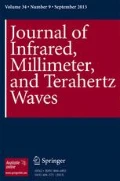Abstract
This report reviews the analysis used to extract the complex conductivity of a compound from a microwave cavity perturbation measurement. We intend to present a generalized treatment valid for any spheroidally shaped sample of arbitrary conductivity which is placed at either the electric or magnetic field antinode of the cavity. To begin with, we establish the relationship between the measured parameters and the conductivity for a spherical sample. Next, we extend these results to the case of spheroids; and for the first time, we cover all different configurations that one can possibly use to study an arbitrary conducting sample inside a cavity: in particular, all possible orientations of the sample with respect to the applied field are solved.
Similar content being viewed by others
References
H. G. Beljers,Physica 14, 629 (1949).
J. G. Linhart, I. M. Templeton, and R. Dunsmuir,Brit. J. Appl. Phys. 7, 36 (1956).
L. D. Landau and E. M. Lifschitz,Electrodynamics of Continuous Media (Pergamon, Oxford, 1984).
K. S. Champlin and R. R. Krongard,IRE Trans. Microwave Theory Techn. MIT-9, 545 (1961).
M. E. Brodwin and M. K. Parsons,J. Appl. Phys. 36, 494 (1965).
L. I. Buranov and I. F. Shchegolev,Instrum. & Exp. Tech. 14, 528 (1971).
M. Cohen, S. K. Khanna, W. J. Gunning, A. F. Garito, and A. J. Heeger,Solid State Commun. 17, 367 (1975).
N. P. Ong,J. Appl. Phys. 48, 2935 (1977).
S. Donovan, O. Klein, M. Dressel, K. Holczer, and G. Grüner,Int. J. Infrared and Millimeter Waves 14 (1993) (subsequent article).
M. Dressel, S. Donovan, O. Klein, and G. Grüner,Int. J. Infrared and Millimeter Waves 14 (1993) (sub-subsequent article).
L. D. Landau and E. M. Lifschitz,Statistical Physics (Pergamon, Oxford, 1984).
J. D. Jackson,Classical Electrodynamics (John Wiley & Sons, New York, 1975).
R. I. Joseph and E. Schlömann,J. Appl. Phys. 36, 1579 (1965).
J. A. Osborn,Phys. Rev. 67, 351 (1945).
A. B. Pippard,Proc. R. Soc. Lond. A A216, 547 (1953).
G. E. H. Reuter and E. H. Sondheimer,Proc. R. Soc. Lond. A 195, 336 (1948).
C. H. Papas,J. Appl. Phys. 25, 1552 (1954).
R. W. Morse and H. V. Bohm,Phys. Rev. 108, 1094 (1957).
J. J. Bowman, T. B. A. Senior, and P. L. E. Uslenghi,Electromagnetic and Acoustic Scattering by Simple Shapes (Hemisphere, New York, 1987).
H. W. Helberg and B. Wartenberg,Z. angew. Phys. 20, 505 (1966).
F. Wooten,Optical Properties of Solids (Academic Press, San Diego, 1972).
G. Arfken,Mathematical Methods for Physicists (Academic Press, New York, 1970).
Author information
Authors and Affiliations
Rights and permissions
About this article
Cite this article
Klein, O., Donovan, S., Dressel, M. et al. Microwave cavity perturbation technique: Part I: Principles. Int J Infrared Milli Waves 14, 2423–2457 (1993). https://doi.org/10.1007/BF02086216
Received:
Issue Date:
DOI: https://doi.org/10.1007/BF02086216




